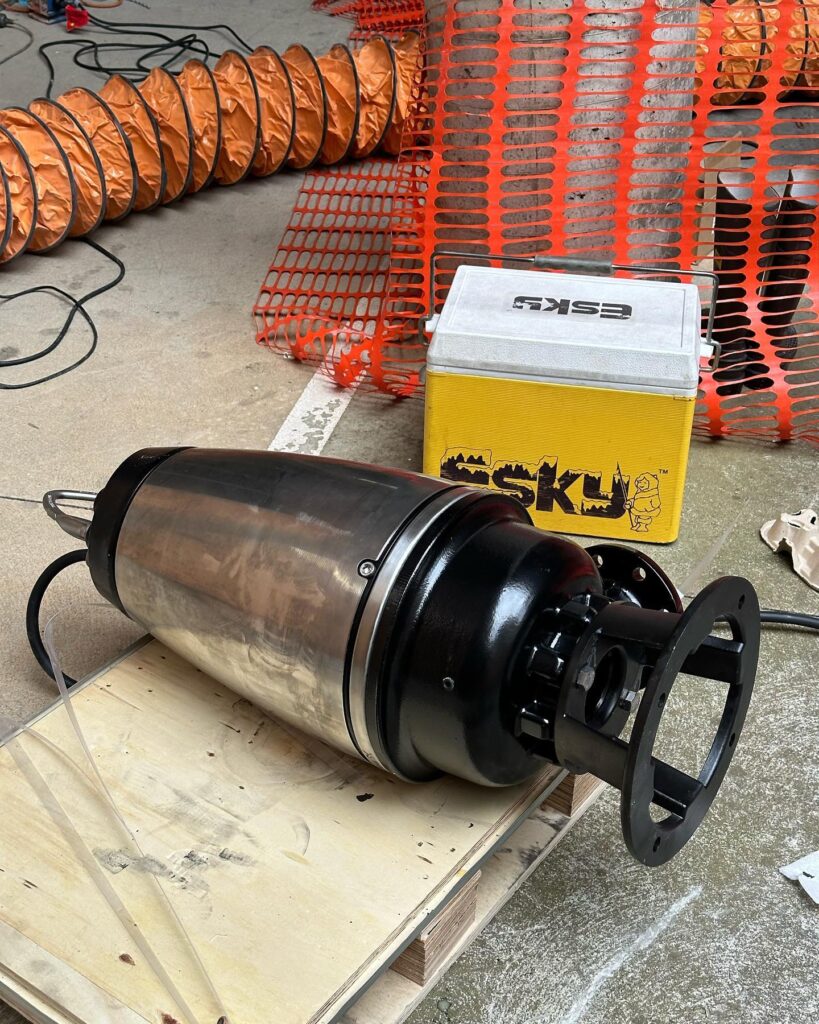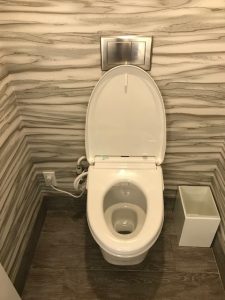We were recently contacted by the facilities manager of Queen Victoria Apartments in Rose Park to attend a fault from their car parks storm water collection chamber. The report was that the emergency red beacon was flashing and the water in the tank was just continually being pushed around yet no water was leaving the below ground tanks.
Key Take Aways
- How to fault find a commercial pumping station
- Working with a pump that weighs 146 kilograms
- Installing a new Grundfos pump
How to fault find a commercial pumping station
Upon arrival to site, we were shown where the pumping station was located. The catchment chamber and the pump were approx. 3 storeys below street level and has a heavy-duty cast-iron lid on it (trafficable given it’s in a car park). This lid had to take traffic from large trucks back when this building was originally the Queen Victoria Hospital back in 1966.
The first thing with these set ups is to attempt to get the lid/grate off! Typically, they have been driven over hundreds of times and been sandwiched in super tight, so this is always a headache and a half to get the lid open first.
Once we finally got the lid off we could see that the pump was just making a whirl pool inside the chamber, something was wrong with the pumps discharge line itself and the water was not making its way out of the chamber? To try and protect the pump we had to isolate the power to it. The control box is mounted above ground a couple of metres away and it delivers 3 phase power to the pump, which means this is going to a huge pump we are dealing with!
Now that power has been temporarily turned off and the water has stopped moving, we need to get access to the pump, but we needed to remove all the water from the chamber first. We hired a submersible pump from Kennard’s Hire Trinity Gardens and 30 metres of 2-inch hose. The pump took approximately 2 hours to completely drain down the tank so we could see what the problem was.
What we also suggested, and the facilities manager agreed to is that we get the entire pit vacuumed out due to the large deposits of sediment that had settled inside the chamber over the many years of being in operation.
The elbow which comes out the pumps discharge line had broken away and this was causing the water to stay in the tank and causing the high-level alarm to go off and keeping the pump constantly running.

Working with a pump which weighs 146 kilograms
Our next challenge was to get the pump out without killing our backs at the same time. Once again Kennard’s Hire came to the rescue, there Lift and Shift department located in Hindmarsh supplied us with an aluminium Gantry capable of lifting 1500 kilograms and a block and tackle to lift the pump.
With all this set up we got the old Grundfos pump out of the ground and up onto dry land. It was at this point the real storey started to come to light and that was that yes the 80mm elbow had snapped off the 100mm pumped discharge line, but the real reason was that the stand which the pump sits on had corroded away causing the weight of the pump to put pressure on the pumped riser and snap at the weakest point!
Although we initially thought that we could repair the snapped fitting the stand which the pump sits on is no longer available as a spare part, so the pump needed to be replaced. After some research with Grundfos the pump was deemed to 54 years old and most likely installed when the location operated as a hospital not apartments. Using the technical data plate Grundfos where able to provide us with a quotation for a newer version of the old pump which will meet the previous model’s performance curve.
Installing the new 3 phase Grundfos submersible pump
As you can imagine a pump such as this is not just going to be lying around on the shelfs in Adelaide and this would need to come from the head office of Grundfos in Sydney, NSW (so approximately 4 business days transit). The order was placed through our local Grundfos distributor here in Adelaide and in the meantime, there was a lot of parts which would need to be sourced locally from various plumbing merchants.
Two key factors to making this new pump work affectively would be installing a Din/Te 80mm vibration control device and a new 80mm brass swing check valve. Both will ensure that the pump will operate at its optimum performance and avoid any unnecessary pressure being put on the pumps motor.
To create a loose point of disconnection between the pump and the main discharge line we installed a new 100mm stainless Gibault fitting. The 3 stainless steel clamp down bolts have a torque rating between 50nm and 70nm and it is recommended that these be done up using a torque wrench with 24mm deep socket.

When the pump arrived in Adelaide, we collected it from the local distributor and delivered it to Rose Park the morning of the job. By using the gantry and the block and tackle we were able to lower the new pump into the collection chamber. Due to the large volume of ground water this far below the street level it was necessary to keep the hired submersible pump running to avoid getting flooded during the installation process.
The underground holding tanks can store around 30,000 litres of water and are constantly being filled via the locations ground water. These tanks also take some of the roof water and some other surface water.
Once the ew pump has been plumbed in it is time to fill the tanks up to a level where the pump can be tested, and the float switches be tested. Given the pump is brand new and has never worked in this pit it had an air lock which we had to remove. The only way of doing this was to un screw the brass 80mm swing check non return valve and purge the air out of the pump’s impeller. While the swing check valve was open, we quickly turned on the pump and pushed the air through, this all happened within seconds and the air lock was removed.
Running the pump through its paces was quite an achievement for the Mayfair Plumbing and Pump crew. The new Grundfos pump effortlessly moves 1500 litres of water per minute, and it does so in such a way that you can barely hear or see the pump moving. The water from the chamber is pumped approximately 5 metres vertically and then pushed out to the streets storm water infrastructure on Fullarton Road opposite the Victoria Park Race Course.
Popular Questions
How do I select the right pump?
You cannot just use any size or style of pump for all applications. When it comes to commercial and industrial installations the pump needs to be professionally sized according to discharge pump line size, length of run, vertical lift and quantity and frequency of liquid being collected and removed. When we size a pump for commercial and industrial applications it’s also important to consider the power source? Either single phase power or 3 phase power connections.
What pumps do Mayfair Plumbing work on?
At Mayfair Plumbing we work on all sizes and types of pumps. We specialise in commercial pump installations and programmed maintenance of all pumps. Some examples of pumps we work with are: Hot water circulating pumps, Storm water submersible pumps, Rain water pressure pumps, Bore pumps, Sewer macerating/grinding pumps, Variable speed water pumps and Transfer pumps.
Majority of our commercial pumps are serviced at quarterly intervals as these clients rely upon the continuity of their pumps working and are on regular maintenance plans with us.
What locations do Mayfair Plumbing work in?
Mayfair plumbing service the entire state of South Australia. We are known for our remote location works. Some of the more common locations that we work in are the CBD of Adelaide, North Adelaide, Hahndorf, Mount Barker, Port Adelaide, Glenelg, and Victor Harbour. We also offer on call 24-hour emergency plumbing services to all these locations when a pump emergency arises.




